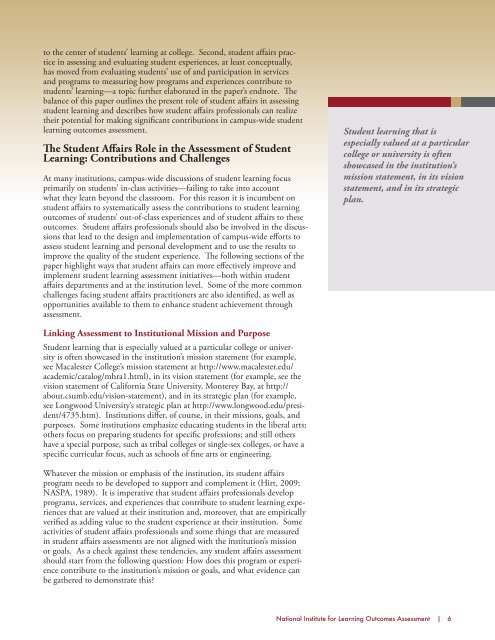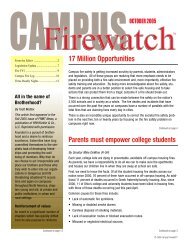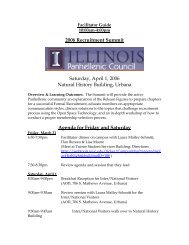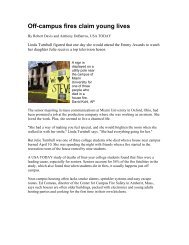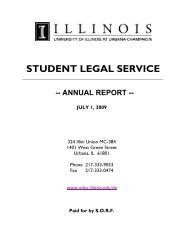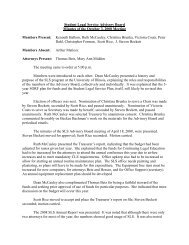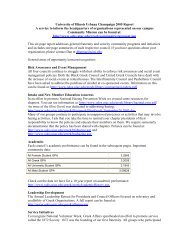StudentAffairsRole in Assessment - Office of the Dean of Students ...
StudentAffairsRole in Assessment - Office of the Dean of Students ...
StudentAffairsRole in Assessment - Office of the Dean of Students ...
Create successful ePaper yourself
Turn your PDF publications into a flip-book with our unique Google optimized e-Paper software.
to <strong>the</strong> center <strong>of</strong> students’ learn<strong>in</strong>g at college. Second, student affairs practice<br />
<strong>in</strong> assess<strong>in</strong>g and evaluat<strong>in</strong>g student experiences, at least conceptually,<br />
has moved from evaluat<strong>in</strong>g students’ use <strong>of</strong> and participation <strong>in</strong> services<br />
and programs to measur<strong>in</strong>g how programs and experiences contribute to<br />
students’ learn<strong>in</strong>g—a topic fur<strong>the</strong>r elaborated <strong>in</strong> <strong>the</strong> paper’s endnote. The<br />
balance <strong>of</strong> this paper outl<strong>in</strong>es <strong>the</strong> present role <strong>of</strong> student affairs <strong>in</strong> assess<strong>in</strong>g<br />
student learn<strong>in</strong>g and describes how student affairs pr<strong>of</strong>essionals can realize<br />
<strong>the</strong>ir potential for mak<strong>in</strong>g significant contributions <strong>in</strong> campus-wide student<br />
learn<strong>in</strong>g outcomes assessment.<br />
The Student Affairs Role <strong>in</strong> <strong>the</strong> <strong>Assessment</strong> <strong>of</strong> Student<br />
Learn<strong>in</strong>g: Contributions and Challenges<br />
At many <strong>in</strong>stitutions, campus-wide discussions <strong>of</strong> student learn<strong>in</strong>g focus<br />
primarily on students’ <strong>in</strong>-class activities—fail<strong>in</strong>g to take <strong>in</strong>to account<br />
what <strong>the</strong>y learn beyond <strong>the</strong> classroom. For this reason it is <strong>in</strong>cumbent on<br />
student affairs to systematically assess <strong>the</strong> contributions to student learn<strong>in</strong>g<br />
outcomes <strong>of</strong> students’ out-<strong>of</strong>-class experiences and <strong>of</strong> student affairs to <strong>the</strong>se<br />
outcomes. Student affairs pr<strong>of</strong>essionals should also be <strong>in</strong>volved <strong>in</strong> <strong>the</strong> discussions<br />
that lead to <strong>the</strong> design and implementation <strong>of</strong> campus-wide efforts to<br />
assess student learn<strong>in</strong>g and personal development and to use <strong>the</strong> results to<br />
improve <strong>the</strong> quality <strong>of</strong> <strong>the</strong> student experience. The follow<strong>in</strong>g sections <strong>of</strong> <strong>the</strong><br />
paper highlight ways that student affairs can more effectively improve and<br />
implement student learn<strong>in</strong>g assessment <strong>in</strong>itiatives—both with<strong>in</strong> student<br />
affairs departments and at <strong>the</strong> <strong>in</strong>stitution level. Some <strong>of</strong> <strong>the</strong> more common<br />
challenges fac<strong>in</strong>g student affairs practitioners are also identified, as well as<br />
opportunities available to <strong>the</strong>m to enhance student achievement through<br />
assessment.<br />
Student learn<strong>in</strong>g that is<br />
especially valued at a particular<br />
college or university is <strong>of</strong>ten<br />
showcased <strong>in</strong> <strong>the</strong> <strong>in</strong>stitution’s<br />
mission statement, <strong>in</strong> its vision<br />
statement, and <strong>in</strong> its strategic<br />
plan.<br />
L<strong>in</strong>k<strong>in</strong>g <strong>Assessment</strong> to Institutional Mission and Purpose<br />
Student learn<strong>in</strong>g that is especially valued at a particular college or university<br />
is <strong>of</strong>ten showcased <strong>in</strong> <strong>the</strong> <strong>in</strong>stitution’s mission statement (for example,<br />
see Macalester College’s mission statement at http://www.macalester.edu/<br />
academic/catalog/mhra1.html), <strong>in</strong> its vision statement (for example, see <strong>the</strong><br />
vision statement <strong>of</strong> California State University, Monterey Bay, at http://<br />
about.csumb.edu/vision-statement), and <strong>in</strong> its strategic plan (for example,<br />
see Longwood University’s strategic plan at http://www.longwood.edu/president/4735.htm).<br />
Institutions differ, <strong>of</strong> course, <strong>in</strong> <strong>the</strong>ir missions, goals, and<br />
purposes. Some <strong>in</strong>stitutions emphasize educat<strong>in</strong>g students <strong>in</strong> <strong>the</strong> liberal arts;<br />
o<strong>the</strong>rs focus on prepar<strong>in</strong>g students for specific pr<strong>of</strong>essions; and still o<strong>the</strong>rs<br />
have a special purpose, such as tribal colleges or s<strong>in</strong>gle-sex colleges, or have a<br />
specific curricular focus, such as schools <strong>of</strong> f<strong>in</strong>e arts or eng<strong>in</strong>eer<strong>in</strong>g.<br />
Whatever <strong>the</strong> mission or emphasis <strong>of</strong> <strong>the</strong> <strong>in</strong>stitution, its student affairs<br />
program needs to be developed to support and complement it (Hirt, 2009;<br />
NASPA, 1989). It is imperative that student affairs pr<strong>of</strong>essionals develop<br />
programs, services, and experiences that contribute to student learn<strong>in</strong>g experiences<br />
that are valued at <strong>the</strong>ir <strong>in</strong>stitution and, moreover, that are empirically<br />
verified as add<strong>in</strong>g value to <strong>the</strong> student experience at <strong>the</strong>ir <strong>in</strong>stitution. Some<br />
activities <strong>of</strong> student affairs pr<strong>of</strong>essionals and some th<strong>in</strong>gs that are measured<br />
<strong>in</strong> student affairs assessments are not aligned with <strong>the</strong> <strong>in</strong>stitution’s mission<br />
or goals. As a check aga<strong>in</strong>st <strong>the</strong>se tendencies, any student affairs assessment<br />
should start from <strong>the</strong> follow<strong>in</strong>g question: How does this program or experience<br />
contribute to <strong>the</strong> <strong>in</strong>stitution’s mission or goals, and what evidence can<br />
be ga<strong>the</strong>red to demonstrate this<br />
National Institute for Learn<strong>in</strong>g Outcomes <strong>Assessment</strong> | 6


